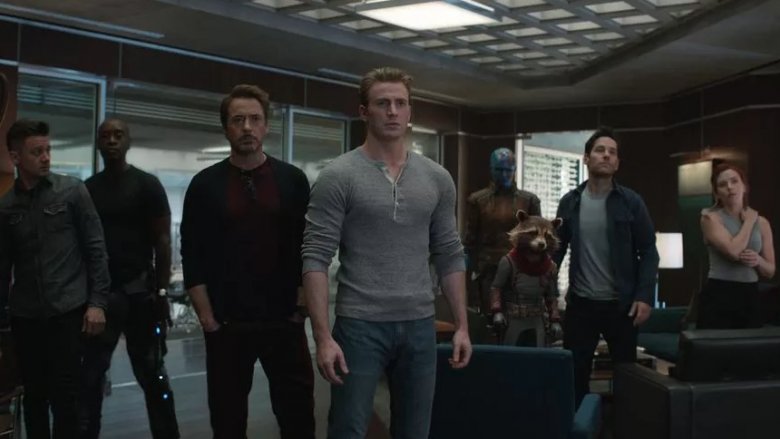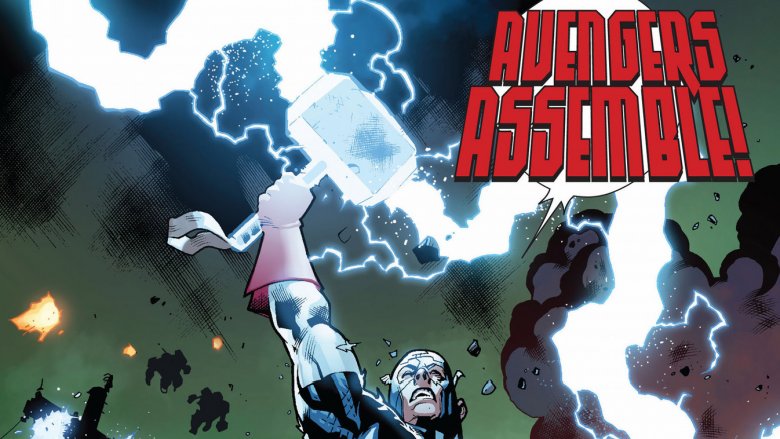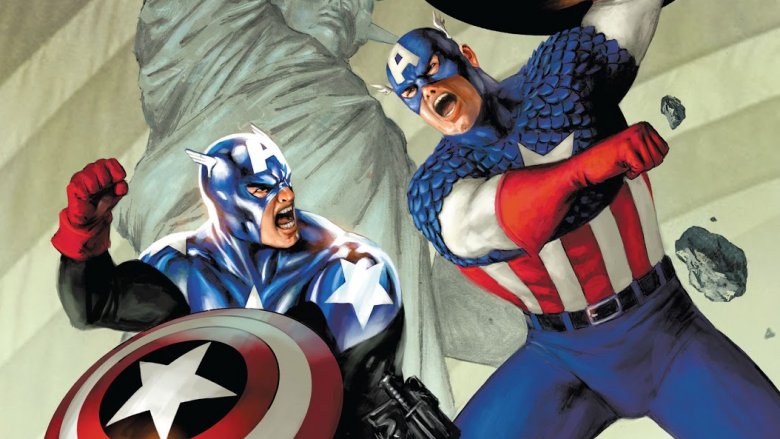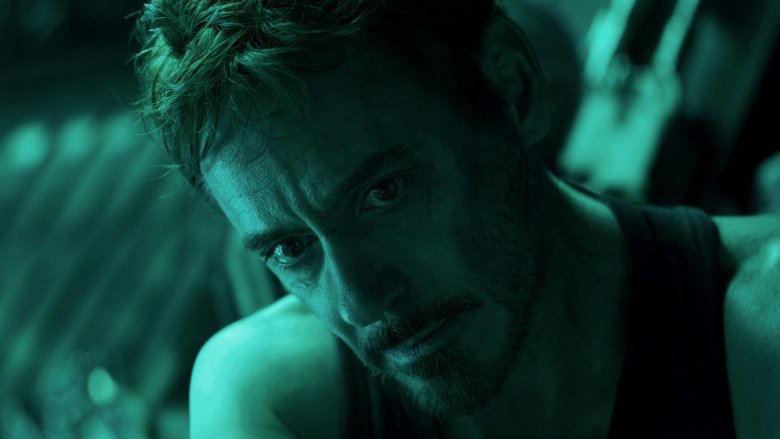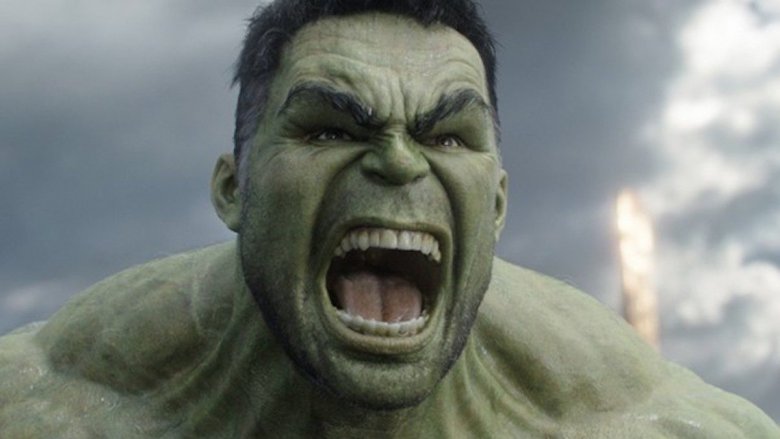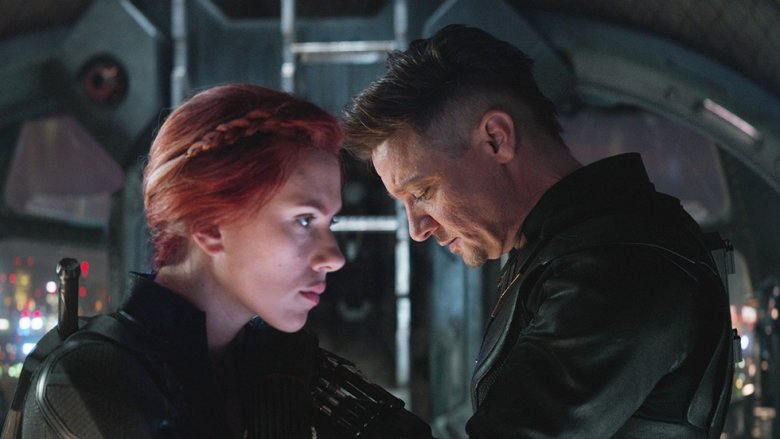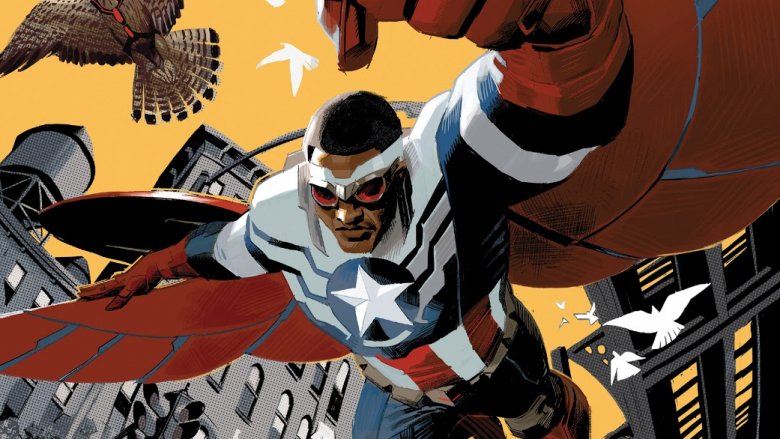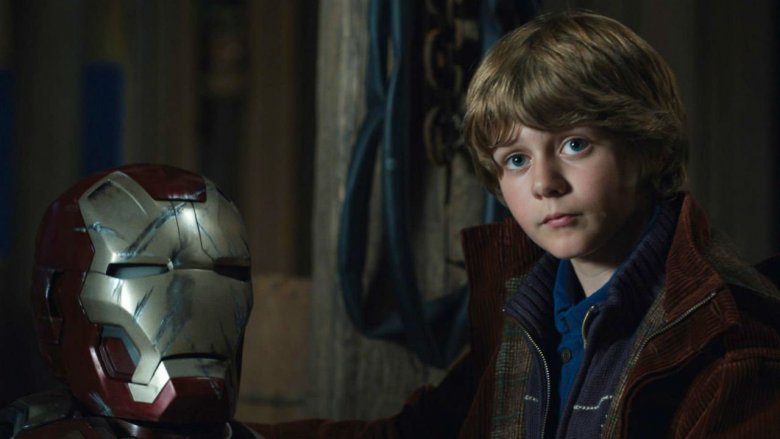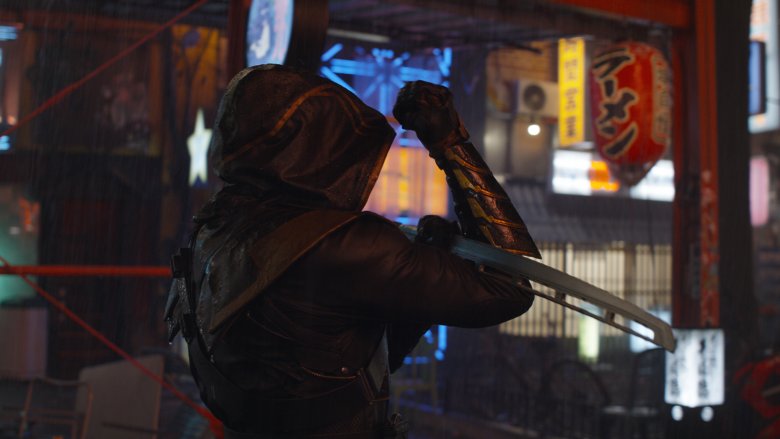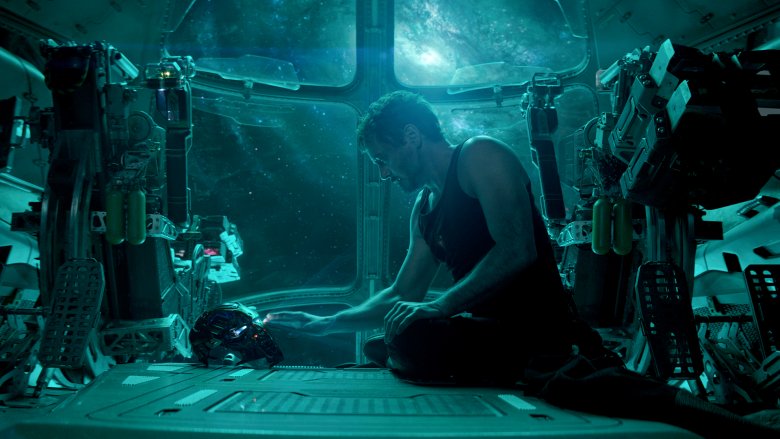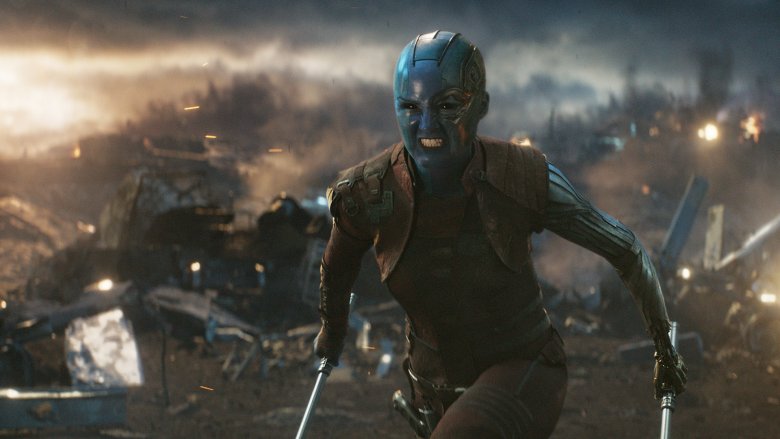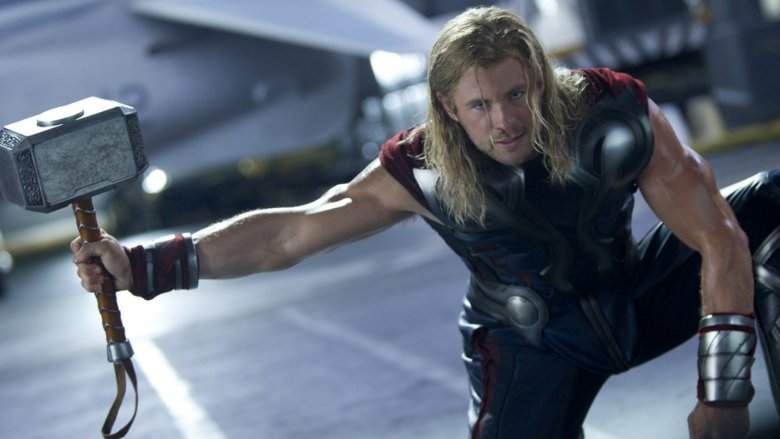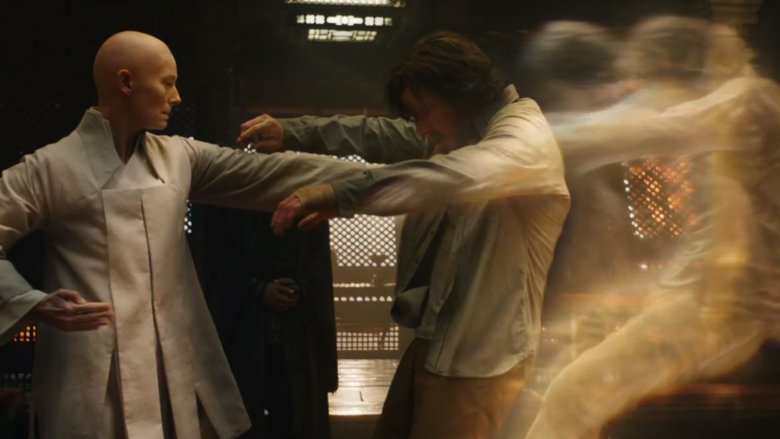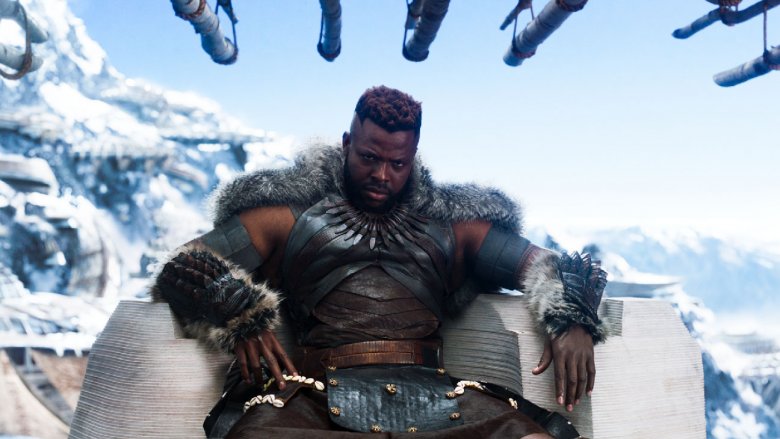Confusing Moments In Avengers: Endgame Explained
The biggest movie event of the year has finally dropped, and fans are yelling, crying, and cheering as the credits roll on Avengers: Endgame. But there's one more emotion that most fans are feeling as they head home from their local movieplex: confusion. In the three-hour-plus runtime of the film, there's a lot of plot to understand — not to mention the nearly two dozen preceding films in the Marvel Cinematic Universe that Endgame called back to.
From time-travel hijinks to that explosive moment with Mjolnir, there's a lot of moments that probably left you scratching your head in confusion even while you were cheering. If so, you don't need to worry. We've course-corrected our galactic maps, read our redacted S.H.I.E.L.D. dossiers, and checked in with FRIDAY and JARVIS about what exactly some of those confusing moments in Avengers: Endgame really meant. Obviously, major spoilers ahead, so do whatever it takes to make sure you're ready.
Why could Captain America lift Thor's hammer?
Easily one of the biggest and best moments in Avengers: Endgame is when Thanos, right on the verge of killing Thor, is smacked in the back of the head by Captain America wielding Mjolnir. It's a stand-up-and-shout moment in a movie filled with them, a moment as appealing to diehard Marvel comic book fans as it is to the average moviegoer. Still, once the excitement settled down, you might've been left wondering just how Steve Rogers was able to lift the hammer, especially when he couldn't quite get it up in Avengers: Age of Ultron.
Well, there's a few different theories floating around. One is that Cap could fully lift Mjolnir in Age of Ultron and just chose not to. The one that makes the most sense to us, though, is that Cap wasn't quite worthy at the time. He was still struggling with his ego and finding a place in the world after being awoken from his time in the ice. The Cap we see in Endgame has completely let go of his ego; he admits that Tony was right to be concerned about Thanos. He admits that he underestimated the severity of the threat, and he wants to make amends with his old friend. In other words, like with Thor's journey in Thor, Steve has put aside ego to be the hero he always could be. And, as we've known for almost a decade in the MCU, "Whosoever holds this hammer, if he be worthy, shall possess the power of Thor."
Did Captain America ruin the timeline when he fought himself?
While we're on the subject of great Captain America-themed moments in Endgame, we'd be remiss if we skipped over that beautiful Captain America v Captain America: Dawn of Just Us battle. While trying to grab the scepter and the Tesseract, Iron Man and Ant-Man accidentally let Loki get away with the Tesseract. That misstep complicates things when a 2012-era Cap runs into a 2023-era Cap carrying the scepter. Past Cap obviously thinks Present Cap is Loki in disguise, and their ensuing Star-Spangled Battle is a highlight of the film.
However, while Present Cap is able to get the upper hand by telling Past Cap that "Bucky's alive" in a callback to Crossbone's similar distraction in Captain America: Civil War, that seems to complicate the future timeline. Well, Present Cap was able to zap Past Cap with the scepter. That's a great way to end a fight, but the scepter also has mind control powers, thanks to the Mind Stone. So it would be child's play to zap Past Cap's memories, so that when the past Avengers arrive to check on Past Cap, all they'll see is the aftermath of a fight and assume that Loki did what Loki does best. Thus, the timeline is secure ... except for every other screw-up the Avengers make in the past. Speaking of...
What even are the rules of time travel in the Marvel Cinematic Universe?
A decent chunk of Endgame is devoted to saying what time travel isn't: It's not Back to the Future, it's not Time Cop, there's Deutch principals, and the Hulk even says that it's impossible to kill Thanos as a baby. When the Hulk travels back to 2012, Tilda Swinton's The Ancient One gives an entirely different explanation: Time is literally controlled by the six Infinity Stones working in harmony, and removing one causes a branch timeline. But the movie also ends with past Thanos fading into dust, Past Nebula getting killed by Present Nebula, and plenty of other things that seem to ignore any and all time travel rules established up to that point.
So, what actually are the rules of time travel? At this point, nobody knows. The easiest answer is that the reason that the Hulk spends so much time talking about what time travel isn't is that they don't actually know what time travel is. In a world with literal magic, celestial gods, and stones that can kill half of the universe and also bring them back, we wouldn't put too much stock in what a scientist says are unbreakable constraints of the universe. In the Marvel comics (specifically Ultimates #5), there's a flow of time that allows events to have "weight" that drags and affects both the future and the past. In effect, certain events can never be changed, while the past and future are always fluidly changing. Basically, expand your mind, maaaaaaan.
Why did Hulk need to wear the Infinity Gauntlet?
Of the surviving Avengers, there's not really a short line in terms of heroes ready to use Iron Man's Gauntlet to revive their friends and family. Thor's been looking for meaning for years, Iron Man's been carrying the weight of guilt, and Cap was ready to do whatever it took. As it turns out, though, it was Hulk who did the snap that undid Thanos' own fateful snap. But why was the Green Goliath the one to wear it?
It comes down to two things: raw strength and an immunity to gamma radiation. We saw in Guardians of the Galaxy that even holding the Power Stone was enough to nearly kill Peter Quill, even with his half-Celestial DNA. All six Stones together were likely to kill just about every member of the Avengers who tried to wield the gauntlet, including Thor. But, as Banner points out while looking at the gauntlet that Tony's built, the Stones give off gamma radiation — and that's what created the Hulk. He's more or less immune to it. It's almost like he was created just for that purpose, the only one who could really be expected to survive the snap... a theory that's proven later in the film after Tony uses the gauntlet with fatal consequences. At the end of the day, despite sort of losing a fight to Thor in Thor: Ragnarok (which was Thor's movie, after all), Hulk really is the strongest one there is.
Why did the Soul Stone appear for Clint when Natasha freely sacrificed her life?
As soon as Natasha and Clint head off to get the Soul Stone from Vormir, audience members who remembered Avengers: Infinity War were likely squirming in their seats. After all, we know that the Soul Stone only appears when someone gives up someone they truly love: "A soul for a soul." Still, Clint and Natasha are both far more heroic than Thanos, and when push comes to shove, they're both willing to push and shove the other one down so that they can jump off the cliff in order to kill themselves to give the surviving member the Soul Stone. It culminates in an almost laughable game of one-upmanship in which they get knocked down and get up again to push the other one aside.
Ultimately, it ends with both of them stuck against the wall of the cliff, with Clint holding onto Natasha below him. She tells him to let her go, and pushes off, sacrificing herself to get the Soul Stone. Why was the scene so long? Well, the easy answer is that the Soul Stone demands a sacrifice of the person who is receiving the Soul Stone. Clint has to actually give up Natasha in order to get it. He can't just stand by while she kills herself. When the film maneuvers itself into placing both characters against the cliff wall, Clint has to let go of Natasha; he has to actively sacrifice her in order to bring his family back to life.
Why did Cap give the shield to Sam and not Bucky?
Chris Evans has been ready to move on to eating carbs and starring in indie movies for years, so it wasn't a complete surprise that he left the MCU on his own terms. After going back in time to return the Stones, he ended up sticking around to marry Peggy Carter and live out his life until 2023, when he showed up as an old man. But just because Chris Evans is done with the MCU doesn't mean that Captain America is. Steve presents Sam Wilson with either a shield that he stole from the past or the same (now-repaired) shield that he fought Thanos with, all as Bucky looked on approvingly.
So why did MCU specifically give the shield to Sam and not Bucky, considering that both of them have worn the mantle of Captain America in the comics? A couple reasons. The big one is that Bucky seems to really like his life in Wakanda, and he's already got his own new superheroic moniker: the White Wolf. The other is that Captain America never actually chose Bucky as his successor in the comics. Instead, Bucky took over for Cap more as necessity when Steve Rogers died (and was unstuck through time). Cap was proud of his one-time sidekick, but the only person he's actively passed on the shield to has always been Sam Wilson. It's only fitting then that Cap would pass his shield along in the same fashion in the MCU.
Who was the kid at Iron Man's funeral?
If you were too busy sobbing your eyes out as nearly all the MCU heroes gathered to pay homage to Tony Stark's life and death at the end of Endgame, you might not have noticed a familiar-looking boy wearing a suit at the funeral. If you assumed it was Spider-Man wearing a different look than usual, we wouldn't blame you. It's a blink-and-you'll-miss-it cameo, but that character is actually Harley Keener, played by Ty Simpkins, the gadget-loving wunderkind who helped Tony out of a jam in Iron Man 3.
The character's appearance does a lot in just a few seconds of screen time. It establishes how closely the Russo Brothers hewed to canon in Endgame, making sure to pay off just about every lingering question fans might have had going into the movie. But it also gives a sly hint at the possible future of the MCU. While Morgan Stark, Pepper Potts, and Rhodey are all candidates for future non-Tony Iron Man movies, Harley is one of the younger heroes of the Marvel universe at this point. With Endgame the culmination of over a decade of storytelling and multiple actors' contracts, the future stars of the MCU are, like Tom Holland's Spider-Man and Brie Larson's Captain Marvel, necessarily going to be younger. Harley could be a future Iron Kid.
Why is Clint wandering around Japan getting into sword fights?
If you were confused when our second look at Clint Barton in Endgame involved him stabbing Yakuza with a weird-looking sword, you're not alone. Clint's serial killing spree of the worst people left after Thanos' snap was a subplot that was introduced quickly and dropped almost as fast. Basically, after Thanos snapped away his family, Clint went mad with grief. Adopting the new identity of Ronin, he went around "punishing" criminals that he believed didn't deserve to live in a post-snap world when his family didn't make the cut. It's a synthesis of a few different stories in the Marvel Universe. There's a bit of the Punisher in there, obviously, but there's also the Ultimate Universe version of Hawkeye, which saw the archer and S.H.I.E.L.D. agent go off the deep end after his family was murdered.
Ronin as a superhero identity to begin with is the usual getup used by superheroes when they need to get up to some dirty business, so it fits perfectly that Hawkeye would use it while traveling the world to kill gangsters. As for his intricate arm tattoo, well, we're not sure we can answer why that exists.
How was Iron Man able to grab the stones from Thanos so quickly?
In the climax of the film, all seems lost. Cap's Mjolnir upgrade can't keep up with Thanos, and even Captain Marvel's strength isn't enough to take down Thanos when he cheats and uses the Power Stone to knock her away. He's about to do another snap to destroy the entire universe when Tony Stark blasts over, grabs the Gauntlet, and somehow steals the Stones. But how did he grab them so fast, especially when he never actually took the Gauntlet off of Thanos in the first place?
Well, unlike the original, the new Gauntlet that Tony Stark built is made entirely of his design. Tony's nanomachines let him control his suit with a thought, and that extends to the Gauntlet that he built. Once he flew over and grabbed the Gauntlet, he could reshape the oversized glove to transfer the stones to his own wrist in a moment. As soon as he touched Thanos' gloved hand, it was all over for the Mad Titan.
How did Past Nebula tap into Present Nebula's memories?
While the Avengers' time heist seems complicated at first, it becomes even more complex once Past Nebula is able to access Present Nebula's memories, cluing Past Thanos in to the Avengers' scheme. It's a major blow against the Avengers' plan, and it seems to come out of nowhere. Instead, it all comes down to technology; specifically, future space technology.
Unlike her sister, Gamora, Nebula was outfitted with a series of cybernetic implants by her abusive father Thanos in order to make up for her lack of expert fighting prowess. Those cybernetic implants basically run on a closed loop, like a Wi-Fi network that Nebula (and Thanos when he taps into it) has access to. When Nebula goes back in time, it's like when you visit a house with a Wi-Fi network that you already have the passcode to. You tap into the system, and it's obvious that you've tapped into the system. Both the past and the present versions of Nebula run on the same loop.
Why does Thor take Mjolnir back from the past?
When Thor and Rocket go back to Asgard during the events of Thor: The Dark World, they're there for one reason only: to get the Reality Stone from Jane's body and return to the present. Instead, Thor pretty quickly goes off the rails, becoming more focused on having one last chat with his mother, Frigga. Rocket handles the Stone extraction while Thor gets to have that one final chat with his mother that he's always wanted, but the scene ends with a moment that probably surprised most audience members.
After his conversation with Frigga, Thor calls his original hammer, Mjolnir, to him, borrowing the tool from his past self. Why did he grab his old hammer when he's got his fancy new axe, Stormbreaker? Well, for starters, after five years of bumming around New Asgard, Thor was starting to wonder if he was still worthy — remember, as far as we know, Stormbreaker doesn't have Odin's enchantment that only the worthy may wield it. The other reason is that the Reality Stone has to be returned to exactly the moment it was taken in order for the timeline to continue normally. That means that there's not really any consequences for borrowing a magical hammer, at least until they have to return the Infinity Stones. And hey, it sure turned out to be useful in the final battle, right?
Why does The Ancient One give Hulk the Time Stone?
Of all the Infinity Stones that the Avengers have to steal during their time heist, you'd expect the Time Stone to be one of the most difficult. After all, unlike the Power Stone or the Space Stone or the Mind Stone, it's not just sitting around in containment. The Time Stone is guarded by the Sorcerer Supreme, which in 2012 is none other than Tilda Swinton's The Ancient One. When the Hulk goes to get it from her, she knocks the soul out of the Hulk and tries to go about her business. But eventually, the Hulk is able to convince her to give up her favorite glowing green rock by dropping Stephen Strange's name.
Soul Bruce tells her that Strange gave up the Time Stone in the present-past of 2018. Even though the 2012 version of The Ancient One hasn't met Dr. Strange, she knows that he's eventually going to become the Sorcerer Supreme, and someone worthy of putting her faith into. Once she hears that giving up the Time Stone is part of his plan, she's willing to gamble her own version of the Time Stone to a similarly massive being. In short, she trusted her pupil.
Who's ruling Wakanda with T'Challa and Shuri gone?
It was a major blow for audiences to find out that Shuri bit the dust during Thanos' snap. Not only was she the wisecracking kid sister of everyone's favorite Panther king of Wakanda, but she would've also been the regent ruler of the kingdom with the acting king gone. Wakanda isn't a democracy, at least in the MCU, and we saw in Black Panther that the path to control over the kingdom requires both a direct bloodline and a ritualized battle. With both of the siblings of the royal line dead, who's ruling Wakanda in their absence?
Well, Akoye survived the snap, and we see her in communication with Black Widow early on in the film, updating her on recent world events. She's certainly a candidate for the throne, since she's both a trusted advisor to T'Challa and someone whose sway in the kingdom clearly carries some weight. But there's another solid contender as well: M'Baku, the leader of the Mountain Tribe, and one of the major contenders for the throne in Black Panther. It's unclear, even in Endgame, whether he survived the snap, but we wouldn't be surprised if Black Panther 2 addresses the lingering question. While Akoye's got the loyalty of the people, M'Baku's got a direct link to the throne, and five years is a long time to wait for another royal challenge.
